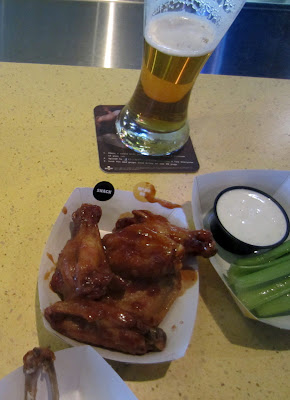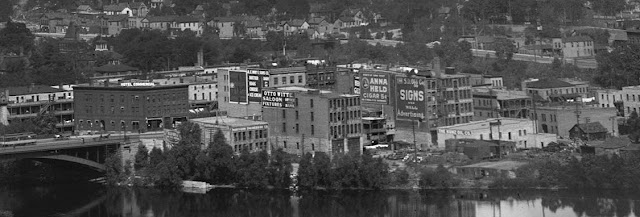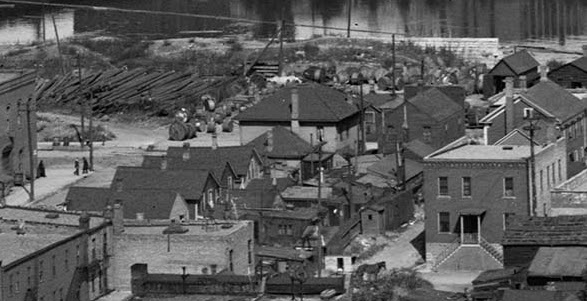 |
| [The MOA Gator's. Now defunct.] |
It is a truth universally acknowledged that the worst bar in modern Twin Cities' history was Gators at the Mall of America. Their combination of depressed people, mediocre food, garish ambiance, and a uniquely soul-rending location on the deserted Mall of America 4th floor set a lofty standard which few extant establishments can ever hope to reach. (The Shout House at Block E is the current worst bar in the Twin Cities, but many more things will have to go wrong to equal Gators metro area record.)
On the other hand, there is general agreement that the best bar in modern Twin Cities' history is
Nye's Polonaise Room. Nye's laudable accomplishments are frequently discussed, and there is little need to repeat them here. It suffices to say that Nye's is the anti-Gators.
Most bars are somewhere in between. They contain happy and sad people, good and bad appetizers, decor to abhor and appreciate. Some places clash with their surroundings, others seem like they've always been there. A wide range of locale sits between Gators and Nye's, and exploring this vast ecosystem of libation is a life long journey.
 |
| [A bit from the facebook page.] |
My curiosity was piqued earlier this year when a bar called Buffalo Wild Wings announced they would be remodeling a mediocre strip mall on Saint Paul's Snelling Avenue, opening up a bar there. Quickly,
neighbors denounced the plan. Buffalo Wild Wings was a nightmare. Its yellow and black logo was inherently ugly. Its promise of drink, food, and sports would mesmerize young people, causing them to walk the streets at night. It would fail to be "family friendly." Allegations mounted like my aunt's horny Cocker Spaniel.
The whole thing intrigued me. The problem was that I'd never been to a Buffalo Wild Wings. I had no idea what the fuss was about. How bad could it be? I wondered. What is this suburban nightmare? How does it rank on the Gator's/Nye's spectrum?
So I laced up my boots, adopted my best jock attitude, and ventured forth to my nearest Buffalo Wild Wings (on the University of Minnesota campus) to research the matter for myself. Here is what I discovered...
 |
| [The UMN BWW.] |
The first thing that happens when you enter a Buffalo Wild Wings? You are greeted at a counter by three young identically clothed bored chipper young people. Two girls and one guy. Some wear headsets. One girl will be twirling her ponytail around her finger like Sarah Jessica Parker in that Steve Martin movie (LA Story?), then she'll smile too widely and say "Wow, I love your jacket!" These people seem to have nothing to do. Because of the headset, one might assume that they're "the brains" of the operation, but after talking to them, it seems unlikely.
Beyond the entrancing counter, a grand canyon of sports bardom opens up before you. It's a bit awe inspiring. The University of Minnesota's Buffalo Wild Wings is in an old fire house, and has tall ceilings and large walls roughly half covered in flat screen TVs. From my barstool, I can see twenty-nine televisions, none of them particularly small. I'm sure I'm missing a few.
The rest of the walls are bedecked in jerzee paraphernalia of different Gopher alumni: Flip Saunders, Neil Broten, Tony Dungy, Gary Steinbeck, others I haven't heard of.
The third thing you notice are the gender dynamics. This is a brotopia. Men rule here, and all the servers are women, gliding like bees in matching black and yellow jerzees with the number 84 on the back. (Why 84? That was the year Buffalo Wild Wings was founded, according to the cloying narrative on the plastic menu. You also learn that Buffalo Wild Wings was fittingly born in Ohio, our most average state.) The gender roles aren't just about the waitstaff, either. Here, with few exceptions, men stare intently, high-five each other, and use nicknames. Girls come to flutter eyelashes and are happy to be excluded in clusters. I've always disliked this aspect of sports. (E.g., despite the fact that seemingly 80% of the staff are women, I'd bet that every Buffalo Wild Wings "manager" is a guy.)
On the other hand, sports is the real saving grace of a Buffalo Wild Wings. Televised sports are inherently corporate, mass marketed, difficult to reconcile with a yearning for the authentic. In a way, Buffalo Wild Wings's pure devotion to sports makes it more honest than an Applebee's, which has to rely on vague notions of "neighborhood."
 |
| [The wild wings (actually honey BBQ)] |
The food is fast, and slightly above average I suppose. Honestly, its difficult to screw up chicken wings. There are a million flavors, but the most popular is Honey Barbeque.
There's little left to say. If you like watching sports on TV and drinking beer, Buffalo Wild Wings is satisfying. You can watch eight different events at the same time: a golf tournament, a Premiere League match, two different baseball games, and hockey highlights. I'm sure that during a live event, a Vikings-Packers game or a Gopher playoff, this place is an electric zoo. Most of the time, it's relatively relaxing, better than some, good if you want to stay anonymous.
I suppose the key thing is that Buffalo Wild Wings is a "corporate bar." This place has the same relationship to the classic sports bars of the U of MN campus -- Sally's, Stub and Herbs, Big 10 -- that Starbucks has to a local coffee shop. It takes all the markers of authenticity and reproduces them according to a formula. I suppose it fools some, others are unconvinced.
The new Saint Paul Buffalo Wild Wings is like a watered down version of Billy's on Grand (sadly, without the patio). I doubt it will be as obnoxious. It will likely be more boring.
Its a cliché to say so, but the line between unique local business and corporate franchise is more blurry than ever. (Though more fiercely guarded, for that reason.) Even a great local Saint Paul bar like the Groveland Tap is undermined by its reproductive owners (the "
Blue Plate Group").
Lucés spread through the burbs. Blue Door Pubs
split like amoeba to cover both sides of the river.
Bulldogs reproduce. What is a chain any more? Does it still matter?
In the end, Buffalo Wild Wings. It ranks somewhere in the middle of the Nye's -- Gator's spectrum, about average with a strong taste of corporate schlock. It's much better than an Applebee's, about equal to a Chili's, and this central location will likely keep it from becoming exceedingly average.
 |
| [The schlocky "story" of Buffalo Wild Wings.] |

















































